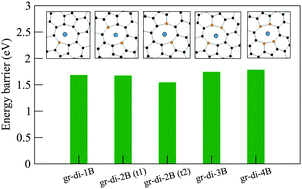Li diffusion through doped and defected graphene†
Abstract
We investigate the effect of

* Corresponding authors
a
Materials Research Centre, Indian Institute of Science, Bangalore 560012, India
E-mail:
abhishek@mrc.iisc.ernet.in
b Korea Institute of Science and Technology, Hwarangno 14-gil 5, Seongbuk-gu, Seoul 136-791, Korea
We investigate the effect of

 Please wait while we load your content...
Something went wrong. Try again?
Please wait while we load your content...
Something went wrong. Try again?
D. Das, S. Kim, K. Lee and A. K. Singh, Phys. Chem. Chem. Phys., 2013, 15, 15128 DOI: 10.1039/C3CP52891J
To request permission to reproduce material from this article, please go to the Copyright Clearance Center request page.
If you are an author contributing to an RSC publication, you do not need to request permission provided correct acknowledgement is given.
If you are the author of this article, you do not need to request permission to reproduce figures and diagrams provided correct acknowledgement is given. If you want to reproduce the whole article in a third-party publication (excluding your thesis/dissertation for which permission is not required) please go to the Copyright Clearance Center request page.
Read more about how to correctly acknowledge RSC content.
 Fetching data from CrossRef.
Fetching data from CrossRef.
This may take some time to load.
Loading related content
